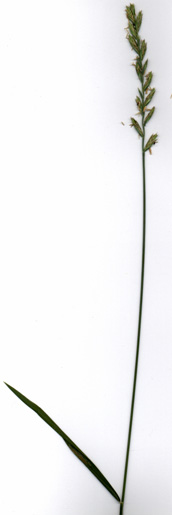
|
| Quackgrass; Elytrigia repens (L.) Desv. |
| = Agropyron repens (L.) Beauv. |
Grass Family; GRAMINEÆ (POACEÆ)
|
| What many people in the Seattle area call "Crabgrass" is the "Quackgrass" of books; so look close at the illustrations of both of
these weeds. The real Crabgrass is less common and less detested than Quackgrass. |
| Quackgrass is a perennial, extremely common, straight, stiff green grass notorious for its pointy, slender, jointed, pale
underground rootstem or rhizome. This is clearly shown in the illustration (the original drawing; not the scan above). Despite being a very costly nuisance, few grasses are better soil-binders,
and it can afford good pasture, silage, forage, or hay --if cut while young. The seeds have been eaten by humans, and it has even been used
in herbal medicine as a diuretic, etc. |
| It grows
11/2 to
21/2 (5) feet tall. The leafblades are about three-eighths of an inch wide, thin, and flat. They appear pinched near
their tips and are usually sparsely hairy. Some Quackgrass specimens bear vivid powder-blue foliage. The stiff, slender floral spikes are 2
to 8 inches long, green, and bloom June onward. |
To get rid of Quackgrass,
mow it consistently and yank up any piece you see. Total elimination for most small gardens takes a
few years. Other names include Quitchgrass, Couchgrass, Dog Grass, Twitch, Devil's Grass, Whickens, Scotch Grass, Witch Grass,
and Quickgrass.
|
Originally published as the Seattle Tilth newsletter Weed of the Month in September 1988, along with an illustration drawn by Sylvan Haven.
Back |
|
|

